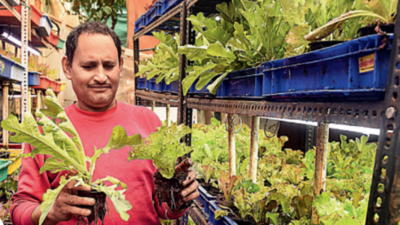
The home garden produces lettuces, spinach, parsley, tomatoes, onion, radishes, carrots, broccoli, guava, fig, grapes and plum
NEW DELHI: When Delhi resident
Peter Satwant Singh
learnt that a possible remedy for his wife’s
leukaemia
was sattvic or unprocessed food, he turned his home in Sainik Farms into a model of sustainability. Now, years after his wife Neeno Kaur’s recovery, the septuagenarian couple continue to grow their own fruit and vegetables through
aquaponics
, besides having a fish farm.

Their house echoes with the sound of flowing water alongside the gently uplifting Shabads. The temperature is regulated without heater or air conditioner and the air is fresh even on a severely polluted day. The
home garden
produces lettuces, spinach, parsley, tomatoes, onion, radishes, carrots, broccoli, guava, fig, grapes and plum. The Singhs even grow maize and mustard, while three ponds give them fresh fish and prawns.
“We moved to Sainik farm in 1989. When my wife was being treated at AIIMS for leukaemia, the doctor also told us about this ayurvedic doctor in Dehradun. We met him and learned about the positive effects of sattvic eating, meaning consuming unprocessed food. We minimised certain food kinds and eventually started growing our own spices and veggies,” said Singh, a 78-year old who studied mathematics at St Stephen’s College and gave up research for progressive farming and bee-keeping.
After a bone marrow transplant in 2009, Kaur made a full recovery by 2011. But this wasn’t the end of their travail. “My wife kept getting lung infection. So our son bought us a home in Goa in 2013 where we stayed in winters to avoid the pollution in Delhi, especially the benzene in the air that aggravates cancers,” recounted Singh. “But there was no organic food in Goa. That is how we discovered aquaponics. I spent a year researching, downloading papers from universities and WHO. In 2015, we developed a small sustainable model that today has expanded into a green house, rooftop garden, fish tanks, vertical farms and over 10,000 plants.”
Explaining how aquaponics works, Singh said the basic need is a fish tank with a pump wavemaker that ensures fish waste collects in the centre of the tank. A pipe transports the fish waste to an area called biofilter, where bacteria break it up into ammonia, nitrates, nitrites, iron and other minerals that in turn flow through pipes to become food for the plants.
“The water goes back to the fish tanks, so it’s a closed loop system,” smiled Kaur. “Aquaponics mimics nature. Like water flowing down the rivers from the hills carrying along nutrients and making the riverbeds in the plains nutrients rich.” She pointed out that there was no chemical or fertiliser involved in the process. The couple use vermi-compost manure made from kitchen waste, banana peels, mustard cake, fish compost and use neem as pesticide.
The Singhs’ point is precise: grow your own food, create a clean environment and manage your waste efficiently. The couple not only recycle their waste into compost but they also recycle the grey water from their septic tank. They have installed rainwater harvesting in their home and use less than 1,000 litres per day. All wastewater is recycled.
As Singh explained, “Onion is a water-hungry crop, but we grow them in 2-3 feet-tall onion towers which consume very little water. We believe that right agricultural practices can help farmers sustain their farms,” said Singh.
The Singhs have even developed a system to combat pollution and heat using khus grass as cover for exhaust fans. “On Diwali day, while the AQI of the city was 800, the PM10 level in our home was 10 micrograms per cubic metre and PM2.5 reading was 5 micrograms per cubic metre. In April, when the outside temperature was 45 degree Celsius, our home was cool at 25 degrees without air conditioners,” said Singh.
Not content simply to live sustainable lives themselves, the couple now hold online courses on aquaponics for people in south Delhi and Gurgaon. “We are now developing a small aquaponic model for a school which approached us to teach their children about sustainable living,” said Singh. The septuagenarians aspire to become “completely sustainable and self-sufficient”, now looking at generating power through home-installed solar panels and atmospheric water generation. Singh has the last word: “People ask me if I will ever retire. Well, I will retire the day I die.”












 English (US) ·
English (US) ·